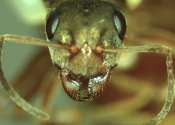Supergenes play a larger role in evolution than previously thought
Massive blocks of genes—inherited together 'plug and play' style—may play a larger role in evolutionary adaption than previously thought, according to new research in Nature.

Massive blocks of genes—inherited together 'plug and play' style—may play a larger role in evolutionary adaption than previously thought, according to new research in Nature.
Evolution
Jul 8, 2020
0
223

Researchers have discovered a social chromosome in the highly invasive fire ant that helps to explain why some colonies allow for more than one queen ant, and could offer new solutions for dealing with this pest.
Biotechnology
Jan 16, 2013
0
1

An ant colony is sustained through complex social dynamics, with each member—the queen, males and workers (sterile females)—contributing to the greater community. Some species add complexity to this dynamic with the addition ...
Ecology
Mar 28, 2024
0
214

In the colorful world of avian courtship, the ruff (Calidris pugnax) is in a league of its own. Breeding in marshes and wet meadows across Eurasia, the males of this medium-sized sandpiper species are well-known for their ...
Evolution
Dec 7, 2023
0
74

Common ragweed, a pest and a major cause of hay fever, is a successful invasive species because it uses "supergenes" to adapt, an international study led by Monash University has found.
Evolution
Mar 28, 2023
0
90

Scientists have solved the century-old mystery of a supergene that causes efficient cross-pollination in flowers. The results show that sequence length variation at the DNA level is important for the evolution of two forms ...
Ecology
Sep 9, 2022
0
24

Within the same species of butterfly many different wing patterns can occur. How is this possible? According to researchers Ben Wielstra and Emma Berdan, of the Institute of Biology Leiden (IBL), the answer lies within supergenes. ...
Evolution
Jun 14, 2022
0
14

Scientists from Queen Mary University of London have discovered that a new form of ant society spread across species. They found that after the new form of society evolved in one species, a "social supergene" carrying the ...
Plants & Animals
Mar 11, 2022
2
946

A new study shows how differentiation of a single gene changes behavior in a wild songbird, determining whether the white-throated sparrow displays more, or less, aggression. The Proceedings of the National Academy of Sciences ...
Plants & Animals
Aug 18, 2020
0
158

House mice carrying a specific selfish supergene move from one population to another much more frequently than their peers. This finding from a University of Zurich study shows for the first time that a gene of this type ...
Plants & Animals
Oct 16, 2018
0
39